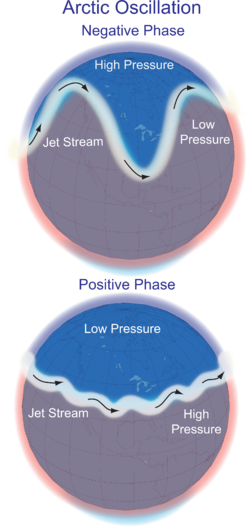Northern Annular Mode

Northern Annular Mode (NAM) also known as Arctic Oscillation (AO) or Northern Hemisphere Annular Mode, is a natural form of climate variability[2], being closely associated with the North Atlantic Oscillation (NAO), which has similar structure over the Atlantic but when looked at from above, the shape is more annular. This makes the pattern regionally symmetric.[3] The NAM is a climate pattern which is described by winds circulating counterclockwise around the Arctic at approximately 55°N latitude.[2] The NAM falls under a mode of climate variability, explaining short and long phases in climate caused by natural, large scale features. Other modes of climate variability include the Atlantic Multidecadal Oscillation, Pacific Decadal Oscillation, and the North Atlantic Oscillation.
The NAM refers to differing atmospheric pressure patterns in middle and high northern latitudes.[4] There are several climate impacts of the annular modes: the NAM is associated with large irregularities in surface temperatures and precipitation across North American and Eurasia regions. It is also associated with the distribution of sea ice throughout the Arctic, as well as sea surface temperatures over the North Atlantic, and in the ozone area located in the lower stratosphere.[5]
Phases of NAM
The oscillation shows a ‘negative phase’ with relatively high pressure over the polar region and low pressure at mid latitudes (roughly 45°N), and a "positive phase" in which the pattern is reversed.[4] The circulating winds around the Arctic become weaker and more distorted in the negative phase of the NAM, which allows an easier southward dispersion of colder, arctic air masses and increased storminess into the mid latitudes.[2]
In the positive phase, higher pressure at mid latitudes drives ocean storms higher up north, and changes in the circulation pattern bringing wetter weather to Alaska, Scotland and Scandinavia, as well as drier conditions to the western United States and the Mediterranean.[4] When the NAM is in its positive phase, a loop of strong winds circulating around the Arctic Circle acts to restrict colder air from moving across polar regions.[2] Positive values of the NAM are associated with lower than normal sea level pressures over the Arctic and westerly wind.[6] In the positive phase, cold winter air does not reach as far into the middle of North America as it would during the negative phase of the oscillation.[4] This keeps much of the United States east of the Rocky Mountains warmer than normal, but leaves areas such as Greenland and Newfoundland colder than usual.[4]
Over most of the past century, the NAM alternated between its positive and negative phases. Since the 1970s, however, the oscillation has tended to stay in the positive phase, causing lower than normal arctic air pressure and higher than normal temperatures in much of the United States and northern Eurasia.[4] Observations and numerical experiments suggest the annular modes have played and will continue to play a role in climate change due to sea surface temperatures increasing.[5]
References
- ↑ Wikicommons. (July 22, 2016). ‘’NAM Modes’’ [Online]. Available: https://upload.wikimedia.org/wikipedia/commons/thumb/7/7a/Arctic_Oscillation.png/250px-Arctic_Oscillation.png
- ↑ 2.0 2.1 2.2 2.3 "Arctic Oscillation (AO) | Teleconnections | National Centers for Environmental Information (NCEI)", Ncdc.noaa.gov, 2016. [Online]. Available: https://www.ncdc.noaa.gov/teleconnections/ao/. [Accessed: 02- Jun- 2016].
- ↑ "3.6.4 The North Atlantic Oscillation and Northern Annular Mode - AR4 WGI Chapter 3: Observations: Surface and Atmospheric Climate Change", Ipcc.ch, 2016. [Online]. Available: https://www.ipcc.ch/publications_and_data/ar4/wg1/en/ch3s3-6-4.html. [Accessed: 03- Jun- 2016].
- ↑ 4.0 4.1 4.2 4.3 4.4 4.5 "Arctic Oscillation (AO) — OSS Foundation", Ossfoundation.us, 2016. [Online]. Available: http://ossfoundation.us/projects/environment/global-warming/arctic-oscillation-ao. [Accessed: 03- Jun- 2016].
- ↑ 5.0 5.1 "Annular Modes", Atmos.colostate.edu, 2016. [Online]. Available: http://www.atmos.colostate.edu/~davet/ao/introduction.html. [Accessed: 02- Jun- 2016].
- ↑ "Northern Annular Mode (NAM) Index | NCAR - Climate Data Guide", Climatedataguide.ucar.edu, 2016. [Online]. Available: https://climatedataguide.ucar.edu/climate-data/hurrell-wintertime-slp-based-northern-annular-mode-nam-index. [Accessed: 03- Jun- 2016].

